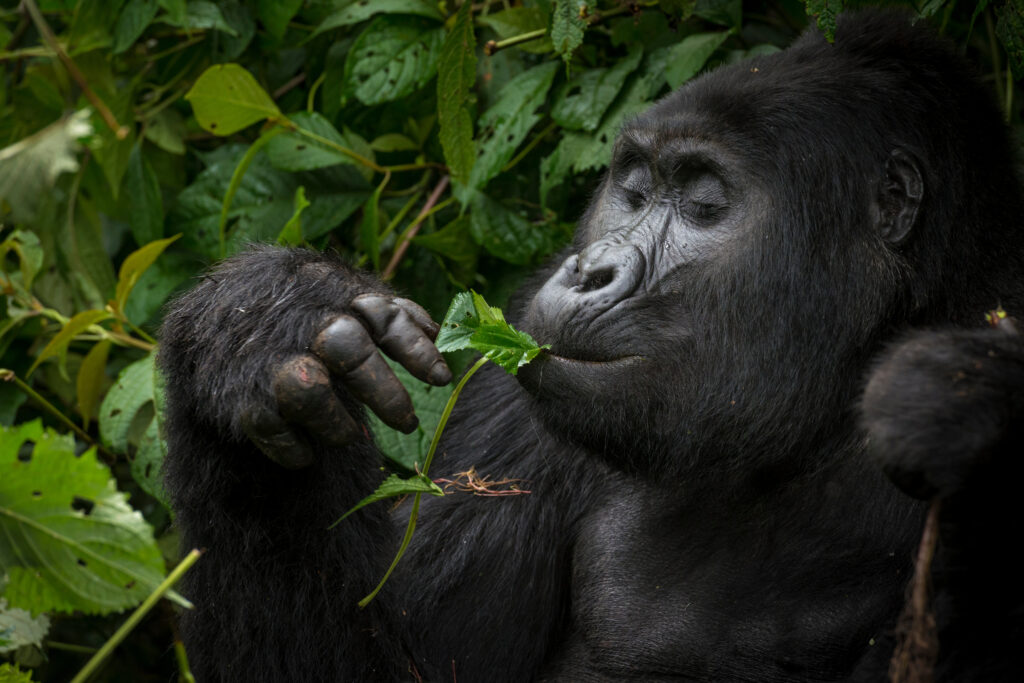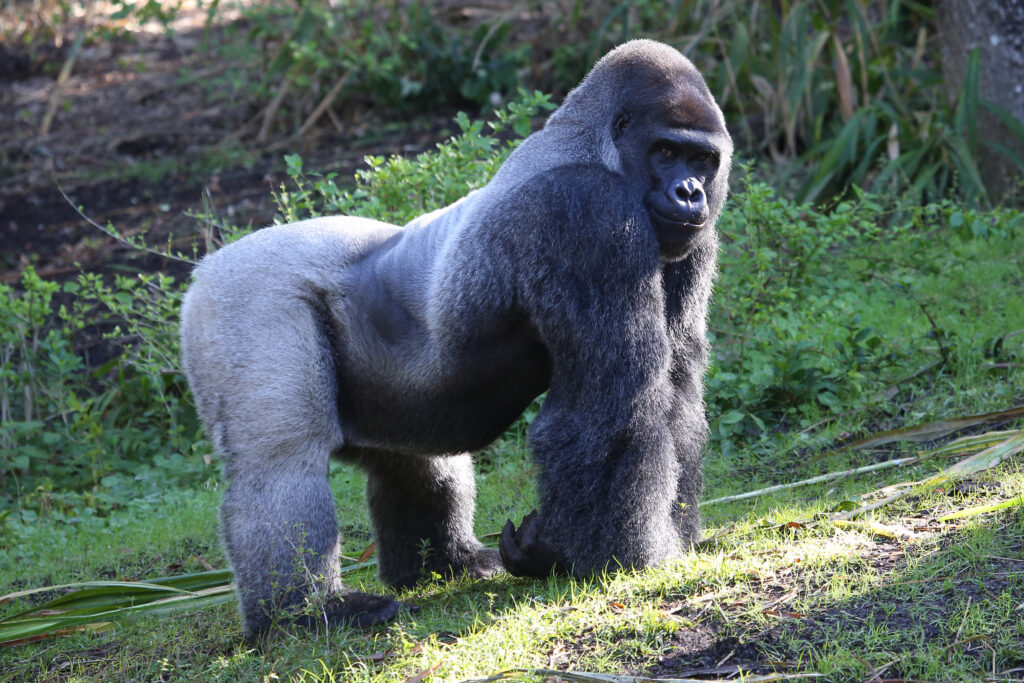
Watching gorillas in Central Africa in their natural habitat is an unforgettable experience. Encountering the last of the mountain and lowland gorillas is the number-one objective for many travellers to the region. And it 's hard to find the right words to describe the emotions that overwhelm us when we meet a gorilla for the first time in the heart of the wilderness! This powerful, muscular colossus has all the makings of a wild beast. Yet when you meet his eyes, you'll see humanity. You only have to look at these mountain giants for a moment to realize just how similar we are. Their gestures, their facial expressions, their ways of communicating - everything echoes our own species. In fact, we share 98% of our genes with them. A privilege reserved for the elite, however, as the price of a permit to visit them is so high. It's also a gamble that aims to better protect them. The best places to see mountain gorillas are undoubtedly Rwanda and Uganda, but also the Democratic Republic of Congo, where lowland gorillas are also found, and can be seen in Congo-Brazzaville. Let's take a look!
Rwanda, temple of the mountain gorilla

Where to go to see gorillas? In the extreme north-west of Rwanda, in the heart of the Volcanoes National Park, live the last remaining Gorilla beringei beringei, the famous mountain gorillas. More imposing and powerful than their cousins on the plains, these black giants can reach 2 meters in height and weigh up to 250 kg. Yet behind their impressive stature, they are peaceful, sociable animals. Twenty gorilla families live together in this 160 km² park, but only twelve are accessible to visitors, the others being protected for research or left in the wild. The adventure begins in the village of Kinigi, at an altitude of 2,200 metres, in the cool of the morning. As most of the gorilla families are several kilometers away, it takes 1 to 3 hours to reach them through the jungle. In groups of eight, accompanied by an experienced ranger, you'll climb until you find yourself with your head in the clouds. This is where these fascinating primates make their home, at an altitude of over 3,000 meters. Unique memories await!
Where to go to see gorillas? In Uganda, other exceptional encounters

It's one of Petit Futé's 15 must-visit destinations in the world: in Uganda, the Bwindi rainforest, over 25,000 years old and a Unesco World Heritage Site since 1994, is one of the world's richest biodiversity reserves and an ideal destination for gorilla watching. It is home to an exceptional range of wildlife, including chimpanzees, forest elephants and, above all, the mountain gorilla, of which almost half the world's population lives here.
The Mgahinga National Park, although the smallest in the country at 34 km², offers a spectacular setting, dominated by three majestic volcanoes: Muhavura (4,127 m), Gahinga (3,474 m) and Sabinyo (3,669 m). This park adjoins the Parc National des Volcans in Rwanda and the Parc National des Virunga in the DRC, together forming the Virunga Conservation Area, a sanctuary for the mountain gorilla, which lives mainly in bamboo forests. Around 45 gorillas live in the Mgahinga region, but in this "golden triangle" linking Uganda, Rwanda and the DRC, these great primates know no borders and move freely. Currently, two families, Nyakagezi I and Nyakagezi II, reside almost permanently in the park, where cross-border groups are regularly observed. However, the unpredictability of their movements makes the issuance of park access permits more uncertain. For travellers who have not obtained a permit for Bwindi, Mgahinga represents a last chance to get close to these fascinating hominids.
Did you know? Uganda is one of the top 10 safari destinations in the world!
Where to go to see gorillas? Off the beaten track in the Democratic Republic of the Congo

Less touristy, the Democratic Republic of Congo allows you to see both mountain gorillas and western lowland gorillas. The Virunga National Park, located in North Kivu, is Africa's first nature park, created in 1925. It offers an exceptional diversity of habitats, ranging from tropical forests and savannahs to the snow-capped peaks of Ruwenzori, lakes Edouard and Kivu, and the active volcanoes of the Virunga chain. This sanctuary is home to some of the continent's richest biodiversity, including the emblematic mountain gorillas, which is why it is listed as a UNESCO World Heritage Site, despite being classified as endangered. However, the park has been severely affected by armed conflict and poaching, having served as a refuge for armed groups, leading to alarming destruction of wildlife. Despite these challenges, a recent revival of the park's tourism activities has provided a new opportunity to discover this unique natural gem. Even so, it is advisable to check safety conditions before embarking on a trip. The region is highly unstable.
Where to go to see gorillas? The Kahuzi-Biega National Park is another option. This is one of the few refuges, and the main one in the DRC, for the Eastern Lowland Gorilla. Although the park is on the list of World Heritage in Danger, it is now possible to reach the park from Bukavu and organize an encounter with the gorillas.
Read more: The Republic of Congo, a surprising destination
Lowland gorillas in Congo-Brazzaville
In Congo-Brazzaville, or Republic of Congo, over 13% of the territory is made up of national parks and reserves, home to exceptional wildlife, including rare and endangered species such as the western lowland gorilla. However, this population has been severely affected by poaching, deforestation and the Ebola epidemic of 2000, which decimated almost half of the country's gorillas. Today, only around 3,000 individuals remain. These great primates can be seen in a number of protected sites, including the Lésio Louna-Sud Léfini reserve, where the Aspinall Foundation is running a program to protect orphaned gorillas, victims of poaching, with the aim of reintroducing them to the wild.
Where to go to see gorillas? Another must-see destination isthe Odzala-Kokoua National Park, which lies in the heart of the world's second largest rainforest after the Amazon. This sanctuary, accessible to travelers, offers an immersive experience thanks to three luxurious lodges nestled in the heart of nature.
Read more: Visiting Odzala-Kokoua National Park: what you need to know


